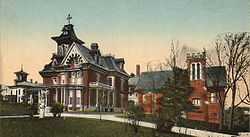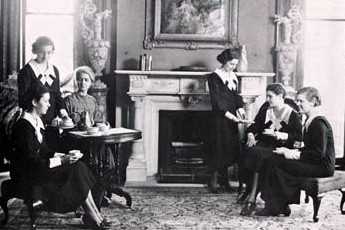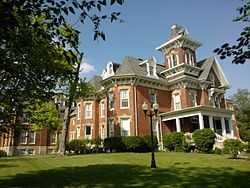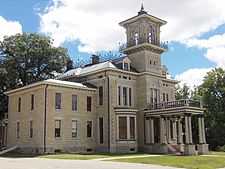St. Katherine's Historic District
|
St. Katherine's Historic District | |
 | |
|
The Renwick Mansion is on the left, Cambria Place is in the center and the chapel is on the right. | |
 | |
| Location |
901 Tremont St. Davenport, Iowa |
|---|---|
| Coordinates | 41°31′43″N 90°33′36″W / 41.52861°N 90.56000°WCoordinates: 41°31′43″N 90°33′36″W / 41.52861°N 90.56000°W |
| Area | 9.4 acres (3.8 ha) |
| Built | 1872 |
| Architect |
John C. Cochrane Edward S. Hammatt |
| Architectural style | Italian Vila (Italianate), Gothic Revival |
| Governing body | Private |
| MPS | Davenport MRA |
| NRHP Reference # | 84001551[1] |
| Added to NRHP | April 5, 1984 |
St. Katherine's Historic District is located on the east side Davenport, Iowa, United States and is listed on the National Register of Historic Places. It is the location of two mansions built by two lumber barons until it became the campus of an Episcopal girl’s school named St. Katharine’s Hall and later as St. Katharine’s School. The name was altered to St. Katharine St. Mark’s School when it became coeducational. It is currently the location of a senior living facility called St. Katherine’s Living Center.
History

In 1883 the Rt. Rev. William Stevens Perry, the second Bishop of Iowa announced his intention to build a school for girls in Davenport. The diocese already operated Griswold College in Davenport. It was founded on property of the former Iowa College, now known as Grinnell College after it moved to Grinnell, Iowa. The school had been founded in 1859 by the Rt. Rev. Henry Washington Lee, the first Bishop of Iowa.[2] A high school for boys, called Kemper Hall, was created later on the campus in 1885. The school was officially closed in 1899. The college property today is the location of Trinity Episcopal Cathedral and Davenport Central High School.
St. Katharine’s Hall replaced Trinity School for girls, which was located in the parish hall of the cathedral. The diocese was able to consider opening a new school for girls based on the will of Sarah Burr from New York City She had bequeathed $30,000 for such a purpose.[3] They chose a residence on the east side of Davenport called “Cambria Place,” the former home of John L. Davies for the location of the school, which opened in 1884. Adelia Rice was the school’s first principal and it had 25 students.[3] The institution was considered a “superior” church boarding school with a college preparatory curriculum. It also allowed day students from the area as well. The school grew quickly and an addition, called St. Mary’s Hall, was built in 1885 and 1886. By its third year there was room for 60 boarding students. While most of the students were Episcopalian, there was no such requirement for admission to the school.

The school continued to grow. In 1888 the Richardson Observatory was built. It was said to contain the finest telescope in Iowa.[4] In 1902 the administration of the school was taken over by the Sisters of St. Mary.[5] St. Mary’s Chapel and a gymnasium were built in 1903 and the neighboring Renwick House was added to the campus in 1909. It was renamed St. Margaret’s Hall.
A former teacher at St. Katharine’s, Marion Crandall, was the first American woman killed in World War I. She had taught French at the school and went to work for the French Canteen. She was killed by an exploding shell in France on March 27, 1918.[6]
Major changes came to St. Katharine’s in the later part of the 20th century. The school discontinued accepting boarding students in 1968 and became co-educational. With the addition of boys the name of the school was changed to St. Katharine St. Mark. In 1973 it moved to the Joseph F. Bettendorf House in neighboring Bettendorf, Iowa. The school amicably broke its ties with the Episcopal Church in 1980. In 2000 the name of the school changed to Rivermont Collegiate.[7]
When the school moved to Bettendorf the property was sold and became a nursing home complex.[8] The buildings started to fall into disrepair until they were bought in 1997 by historic property developer Chris Ales and it was converted into a senior living center in 2001. The facility was transformed into 38 low-income senior citizen apartments.[9] The Renwick House was renovated by Ales for his company’s headquarters, but he was forced to sell the property to Dr. Joseph Seng in 2007.[10] It is now a bed and breakfast.[8]
Mass Mound

There is a legend in the city of Davenport that it will be spared from destruction by a tornado because of the Mass Mound.[11] In 1835 after a period of intense storms a Jesuit missionary, the Rev. Charles Van Quickenborne, SJ, led the first Christian service in what would become the city of Davenport. He erected a crucifix made from native black walnut on a crude altar placed on top of what he called a Mass Mound. It was located on the side of the hill, which is located on the St. Katharine’s property.[12] He gathered both the white settlers and the Native Americans in the region regardless of their faith and celebrated Mass for a week. On the last day he celebrated Benediction of the Blessed Sacrament and blessed the area to preserve it from storms and tornadoes.
The early settlers in Davenport considered the spot a sacred place.[11] Rev. J.A.M. Pelamourges, the first pastor of St. Anthony’s Church in Davenport regularly meditated at the site and was known to spend the night in prayer there before the cross before major decisions or when problems arose. Eventually the crucifix fell apart and was taken away.[13] In time lumber baron John L. Davies built his home on the property before the Diocese of Iowa bought the property for St. Katharine’s.
A fire erupted at several lumber mills on July 24, 1901 in the Village of East Davenport. It destroyed 20 acres (8.1 ha) of land, 250 people were left homeless and businesses suffered $1.25 million in losses.[14] When the fire got to St. Katharine’s the wind shifted towards the river. The Mass Mound was credited for sparing the rest of the city.[11][14]
A shrine was erected in 1928 at the Mass Mound site to the southwest of where the main building is located.[13] It was blessed by the Rt. Rev. Theodore N. Morrison, the third Bishop of Iowa. An altar dedicated to St. Joseph was blessed by Dean Philbrook of Trinity Cathedral on April 29, 1931.[12] The altar was moved to Bettendorf when St. Katharine St. Mark’s School relocated to the Bettendorf Mansion.
Architecture

Both Cambria Place and the Renwick Mansion were designed by John C. Cochrane, who was one of Davenport’s first professional architects.[15] His most famous work was the Iowa State Capitol in Des Moines. Both houses were built in the Italian Villa style, which Cochrane introduced to Davenport. Cambria Place was built in 1872. It was constructed of red brick, with a hipped roof covered in slate, ornamented eve brackets, decorative gabled dormers and different window shapes.[16]
The Renwick Mansion was built by lumber baron William Renwick in 1877. It features a large three-story entry tower, ornate iron cresting, 12-foot (3.7 m) to 14-foot (4.3 m) high wood parlor doors, eight fireplaces and a three-story staircase.[8] Renwick also built the Renwick Building downtown and it is also listed on the National Register of Historic Places.
The additions designed in the 1880s by Edward S. Hammatt, who also designed the buildings for Kemper Hall, were designed to match Cambria Place. While the chapel and gymnasium additions were also brick, their buttresses and pointed-top windows suggest the Gothic Revival style.
References
- ↑ "National Register Information System". National Register of Historic Places. National Park Service. 2010-07-09.
- ↑ Horton, Loren N. (2003). The Beautiful Heritage: A History of the Diocese of Iowa. Des Moines: Diocese of Iowa. p. 41.
- ↑ 3.0 3.1 Horton, 53.
- ↑ Horton, 54
- ↑ Sister Mary Hilary, CSM. "Ten Decades of Praise: The Story of the Community of Saint Mary during Its First Century". Project Canterbury. Retrieved 2010-09-27.
- ↑ Horton, 76-77
- ↑ "History". Rivermont Collegiate. Retrieved 2010-09-27.
- ↑ 8.0 8.1 8.2 "William Renwick Mansion Bed & Breakfast, 1877: 901 Tremont Ave.". Quad-City Times. Retrieved 2010-10-05.
- ↑ Rugger, Todd. "New plans for empty school". Quad-City Times (September 19, 2002). Retrieved 2010-09-27.
- ↑ Gaul, Alma. "Ales looks to the future after running into 'cash pinch'". Quad-City Times (June 18, 2007). Retrieved 2010-09-27.
- ↑ 11.0 11.1 11.2 Bill Wundram (2007-06-02). "Did Mass Mound save Davenport again?". Quad-City Times. Retrieved 2012-02-01.
- ↑ 12.0 12.1 Sr. Esther, CSM. "The Mass Mound of St. Katherine's". Project Canterbury. Retrieved 2012-02-01.
- ↑ 13.0 13.1 Federal Writers' Project of the Works Progress Administration for the State of Iowa. Iowa: A Guide to the Hawkeye State. New York: Hastings House. p. 224.
- ↑ 14.0 14.1 Anderson, Fredrick I. (ed.) (1982). Joined by a River: Quad Cities. Davenport: Lee Enterprises. p. 84.
- ↑ Svendsen, Marls A., Bowers, Martha H (1982). Davenport where the Mississippi runs west: A Survey of Davenport History & Architecture. Davenport, Iowa: City of Davenport. p. 13-1.
- ↑ Svendsen, 10-1.
External links
| ||||||||||||||||||||||||||
| ||||||||||||||||||||||